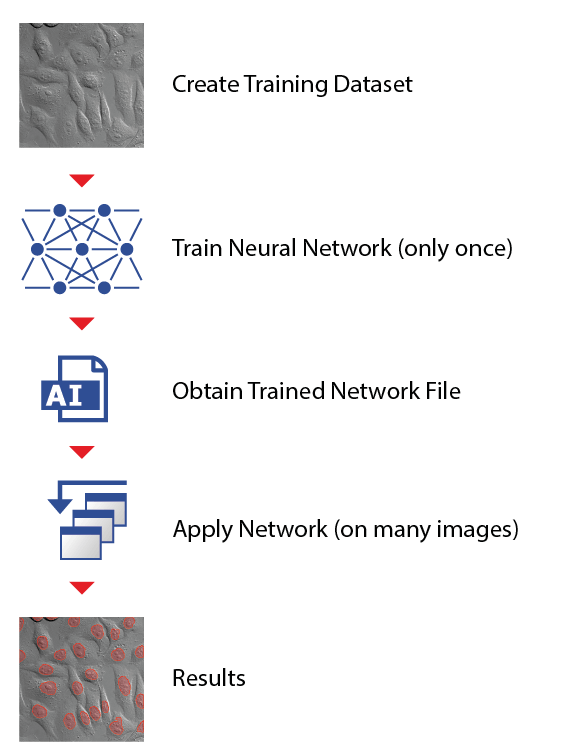NIS.ai module in NIS-Elements is an artificial intelligence (AI) module, based on U-Net, that utilizes deep learning and neural networks to automatically perform image processing tasks. The traditional approach of tuning parameters of common image processing algorithms is very time consuming and prone to error. NIS.ai provides an AI-powered automated solution to address these issues, as demonstrated in the diagram below:
NIS.ai brings main benefits for:
Samples unsegmentable by common methods.
Label free samples (Transmitted light images are usually impossible to segment by standard techniques like Threshold, Spot Detection, etc.).
Samples with a low signal (enhance the signal and prolong viability, reduce light and chemical toxicity of living cells).
With NIS.ai it is possible to:
Train more than one channel set as input or output.
With Convert.ai, Segment.ai and Segment Objects.ai you can train M -> N (M, N >= 1).
With Enhance.ai you can train M -> M (M >= 1, number of channels has to be the same for input and output).
Training multiple channels at once is better than training them one by one.
Train on multiple image files on your hard drive. Channels or binaries used for the training must be present in all listed image files and must have the same name in each file. Two channels having the same name in one document cannot be used. Image sizes and types can be freely combined (e.g. first file 1024 x 1024 px 8-bit with the second file 512 x 512 px float).
Train on RGB images.
Combine the channels (e.g. on an RGB image segment two cell types).
Segment multiple classes at once (e.g. four cell types, see Segment.ai Example).
Convert modalities (e.g. from a Brightfield channel create DAPI and FITC).
Train multiple networks using a queue. Simply click Add to Queue (on multiple files and networks) and then click Train Queued in NIS.ai Explorer.
Train multiple networks on a dedicated cluster of computers to better manage the workload across various workstations. Click Add to Cluster and the cluster system automatically selects the best computer for your task and starts processing it. You can even turn off your computer while the cluster system works on your tasks.
Note
The channel order should remain the same in training and forward. If the document used for training contains DAPI and FITC channel, dataset with the exact channel order should be used for running the AI process.
Four main functions, each suited to a different use case, are available – Image Enhancement (Enhance.ai), Convert modality (Convert.ai), General Segmentation (Segment.ai) and Object Segmentation (Segment Objects.ai). The general usage of NIS.ai is as follows:
Pick a training dataset, which contains ground truth that AI learns.
Train AI on this dataset.
Evaluate AI on another but similar dataset (data not used for AI training).
If results are sufficient then you can use this AI to process any other images you have automatically.
If results are not sufficient you can extend your training dataset and retrain the AI.
